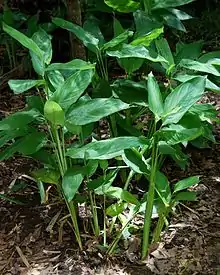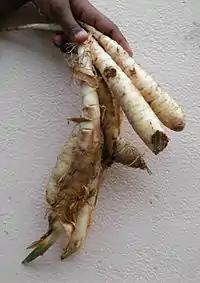| Arrowroot | |
|---|---|
 | |
| Scientific classification | |
| Kingdom: | Plantae |
| Clade: | Tracheophytes |
| Clade: | Angiosperms |
| Clade: | Monocots |
| Clade: | Commelinids |
| Order: | Zingiberales |
| Family: | Marantaceae |
| Genus: | Maranta |
| Species: | M. arundinacea |
| Binomial name | |
| Maranta arundinacea | |
| Synonyms[1] | |
| |
| Nutritional value per 100 g (3.5 oz) | |
|---|---|
| Energy | 271 kJ (65 kcal) |
13.39 g | |
| Dietary fiber | 1.3 g |
0.2 g | |
4.24 g | |
| Vitamins | Quantity %DV† |
| Thiamine (B1) | 12% 0.143 mg |
| Riboflavin (B2) | 5% 0.059 mg |
| Niacin (B3) | 11% 1.693 mg |
| Pantothenic acid (B5) | 6% 0.292 mg |
| Vitamin B6 | 20% 0.266 mg |
| Folate (B9) | 85% 338 μg |
| Minerals | Quantity %DV† |
| Iron | 17% 2.22 mg |
| Magnesium | 7% 25 mg |
| Manganese | 8% 0.174 mg |
| Phosphorus | 14% 98 mg |
| Potassium | 10% 454 mg |
| Zinc | 7% 0.63 mg |
| |
| †Percentages are roughly approximated using US recommendations for adults. Source: USDA FoodData Central | |
Maranta arundinacea, also known as arrowroot,[2] maranta,[2] West Indian arrowroot,[2] obedience plant, Bermuda arrowroot, araru, araruta, ararao or hulankeeriya, is a large, perennial herb found in rainforest habitats of the Americas, but cultivated in tropical regions worldwide.
Description

Arrowroot is a perennial plant growing to a height of between 0.3 m (1 ft) and 1.5 m (5 ft). Its leaves are lanceolate. The edible part of the plant is the rhizome. Twin clusters of small white flowers bloom about 90 days after planting. The plant rarely produces seeds and reproduction is typically by planting part of a rhizome with a bud. Rhizomes are ready for harvesting 10–12 months after planting as the leaves of the plant begin to wilt and die. The rhizomes are fleshy, cylindrical, and grow from 20 cm (8 in) to 45 cm (18 in) long.[3]
The arrowroot plant probably originated in the Amazon rainforest of northwestern Brazil and neighboring countries. It grows best between temperatures of 23 °C (73 °F) and 29 °C (84 °F) with annual precipitation between 150 cm (59 in) and 200 cm (79 in). The dormant rhizomes can withstand temperatures as low as 5 °C (41 °F).[4]
In the continental United States, arrowroot is cultivated as an outside plant only in southern Florida.[5]
Distribution
Maranta arundinacea is native to Mexico, Central America, the West Indies (Cuba, Hispaniola, Puerto Rico, and most of the Lesser Antilles) and South America (in Brazil, Peru, Ecuador, Colombia, Venezuela, Suriname, Guyana, and French Guiana).[2] It is widely cultivated in many warm countries and is considered naturalized in The Bahamas, Bermuda, Cambodia, China (Guangdong, Guangxi, Hainan, Yunnan), the Cook Islands, Equatorial Guinea, Gabon, India, Indonesia, Jamaica, Japan (in the Volcano Islands), Mauritius, the Netherlands Antilles, Réunion, Samoa, Sri Lanka, Taiwan, Trinidad, Tonga, the United States (Florida), the Philippines and Vanuatu.[6][7]
The Caribbean island nation of St. Vincent and the Grenadines is the world's largest grower of arrowroot and producer of arrowroot flour.[8] In Kerala, India, arrowroot, locally called bilathi koova, is cultivated to produce an easily digestible starch.[9]
Prehistoric domestication
Radio-carbon dating has established that M. arundinacea was one of the first plants domesticated in prehistoric South America. Arrowroot, along with leren (Calathea allouia), squash (Cucurbita moschata), and bottle gourd (Lagenaria siceraria) became cultivated plants in northern South American and Panama between 8200 BC and 5600 BC.[10] Some archaeologists believe that arrowroot was first used by indigenous peoples not as food but as a poultice to extract poison from wounds caused by spears or arrows.[11]
Evidence of the use of arrowroot as food has been found dating from 8200 BC at the San Isidro archaeological site in the upper Cauca River valley of Colombia near the city of Popayán. Starch grains from arrowroot were found on grinding tools. It is unclear whether the arrowroot had been gathered or grown, although the elevation of the site of 1,700 metres (5,600 ft) is probably outside the normal range of elevations at which M. arundinacea grows in the wild. Thus, the plant may have been introduced at San Isidro from nearby lowland rainforest areas in a pioneering effort to cultivate it. Stone hoes for the cultivation of plants have been found which date as old as 7700 BCE in the middle Cauca valley, 150 kilometres (93 mi) north of San Isidro.[12]
Domestication of arrowroot at these early dates was probably on a small scale with gardens of only a few plants being planted in alluvial soils near streams to ensure the steady supply of moisture needed during the growing season by arrowroot and other similar root crops. The exploitation of arrowroot was probably complicated by the difficulty of extracting the starch from the fibrous roots. The roots must first be pounded or ground then soaked in water to separate the starch from the fibers. The starch is excellent for digestibility.[13]
Uses
Currently arrowroot starch is used in food preparations and confectionery, and for industrial applications such as cosmetics and glue. The residue of starch extraction has a high fibre content and can be fed to livestock.[14]
Gallery
 Arrowroot flower
Arrowroot flower
References
- ↑ "World Checklist of Selected Plant Species".
- 1 2 3 4 "Maranta arundinacea". Germplasm Resources Information Network. Agricultural Research Service, United States Department of Agriculture. Retrieved 12 January 2018.
- ↑ Root Crops, NRI, 1987. http://www.nzdl.org/gsdlmod?e=q-00000-00---off-0fnl2%2e2--00-0----0-10-0---0---0direct-10---4-----sti--0-1l--11-en-50---20-about-root+crops+--00-0-1-00-0--4----0-0-11-10-0utfZz-8-00&a=d&c=fnl2.2&srp=0&srn=0&cl=search&d=HASHd8d905db1c6eae0daee48f.22; FAO, "Maranta arundinacea", http://ecocrop.fao.org/ecocrop/srv/en/cropView?id=2335 Archived 2017-05-10 at the Wayback Machine, accessed 19 Feb 2016
- ↑ "Maranta arundinacea", http://tropical.theferns.info/viewtropical.php?id=Maranta+arundinacea, accessed 19 Feb 2016
- ↑ "Arrowroot -- "Moscata arundinecea" EDIS, University of Florida, https://edis.ifas.ufl.edu/mv009, accessed 19 Feb 2016
- ↑ Kew World Checklist of Selected Plant Families, Maranta arundinacea
- ↑ Flora of China v 24, p 382, Maranta arundinacea
- ↑ "Root Crops"
- ↑ "Koova (arrowroot), http://papanasini.blogspot.com/2014/01/koova.html, accessed 21 Feb 2016
- ↑ Piperno, Dolores R. (Oct 2011), "The Origins of Plant Cultivation and Domestication in the New World Tropics", Current Anthropology, Vol 52, No. 54, p. S 459. Downloaded from JSTOR.
- ↑ Piperno, Dolores R. and Pearsall, Deborah M. (1998), The Origins of Agriculture in the Lowland Neotropics, San Diego: Academic Press, p. 115, 199
- ↑ Piperno and Pearsall, pp. 199-203
- ↑ Piperno and Pearsall, pp 115, 202
- ↑ Heuzé V., Tran G., 2017. Arrowroot (Maranta arundinacea). Feedipedia, a programme by INRA, CIRAD, AFZ and FAO. https://www.feedipedia.org/node/545 Last updated on July 17, 2017, 14:10